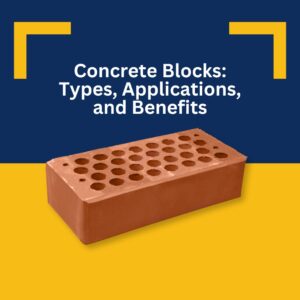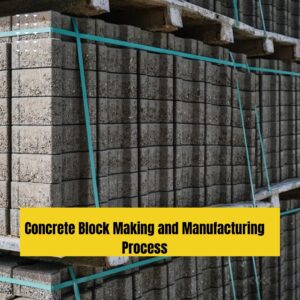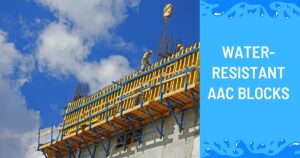Autoclaved Aerated Concrete (AAC) blocks have revolutionized the construction realm with their stellar combination of strength and lightness. Manufactured through a process involving the aerating of concrete, these blocks are not only durable but also feature high thermal and sound insulation qualities. In This article we will talk about what is AAC blocks. So, let’s go.
Builders and architects favor AAC blocks due to their eco-friendly nature and the increased efficiency they bring to construction projects. Their ease of use and versatility make them suitable for a wide range of applications, from residential to commercial structures. As the demand for sustainable and efficient building materials rises, AAC blocks stand out as a formidable choice for modern construction needs.
AAC blocks are a lightweight, precast building material that offer excellent insulation and are used in construction. ACC blocks, however, are not a recognized term in the building industry and may be a confusion with AAC.
Aac And Acc Blocks Unpacked
AAC blocks, short for Autoclaved Aerated Concrete blocks, are eco-friendly and lightweight. They are used to build walls. ACC blocks, on the other hand, are not common. Most people mean AAC when they say ACC.
AAC blocks have many benefits for building strong structures. They are fire resistant and provide excellent insulation. This keeps homes cooler in summer and warmer in winter.
These blocs are also very light. This makes them easier to use in construction. Builders prefer them because they reduce the weight of buildings. This in turn helps to lower construction costs.
How is AAC made? Material Composition And Production
AAC blocks, short for Autoclaved Aerated Concrete blocks, are lightweight building materials. These blocks have high insulation properties and are fire-resistant. They are made from a mix of several raw materials.
- Silica sand or fly ash is the main source of silicon.
- Cement acts as a binding agent for the blocks.
- Lime, mixed with sand, creates calcium silicate.
- Aluminum powder is used in very small amounts.
- And water reacts with the other materials to form pores.
Producing AAC blocks involves mixing these materials into slurry. The mixture is then poured into molds. It’s allowed to set and cut into blocks or panels. A high-pressure steam process, called autoclaving, gives the blocks strength. Finally, the blocks are dried, packed, and ready to use.
Comparing Aac And Acc Blocks
Before knowing what is aac blocks then you should must know about it. AAC (Autoclaved Aerated Concrete) blocks are lighter than ACC (Autoclaved Concrete) blocks. This fact greatly influences construction techniques and costs. For example, a standard AAC block can weigh about 50% less than a similar ACC block. This significant weight difference means less load on structures and easier handling during construction.
Regarding thermal and acoustic properties, AAC blocks provide excellent insulation. They keep interiors cool in the summer and warm in the winter, reducing energy costs. AAC blocks also limit sound transmission, making them ideal for noise-sensitive environments. Conversely, ACC blocks, while still insulative, may not match the thermal efficiency and sound reduction capabilities of AAC blocks.
Benefits of AAC Blocks
AAC (Autoclaved Aerated Concrete) blocks are rising stars in building materials. Environmentally conscious folks love them. They’re made with non-toxic products and can be easily recycled. Plus, they help in reducing construction waste. By using these blocks, builders cut down on the carbon footprint.
As for saving money, AAC blocks are a smart pick. They are lightweight, which means lower shipping costs. Builders use fewer materials because these blocks are large. They also speed up the construction which saves time and money. And there’s more – these blocks insulate buildings well. This means less spending on heating and cooling.
The biggest advantage of these AAC blocks is their thermal efficiency. In summer and winter, the house will be more pleasant to live in, and the heating and cooling load will be reduced.
It is more effective in extinguishing fire than ordinary blocks.
These blocks are lighter than traditional clay or cement blocks, making them about three times more portable.
Individual blocks are much larger in size than clay bricks but more precisely. For this comes the perfect dimension without any need to lay off. As a result, structure completion will be faster.
For large construction, AAC blocks are better than the price of mud brick.
No toxic substances are used to manufacture AAC Blocks, thereby maintaining environmental balance.
The porous material of AAC block helps in absorbing moisture naturally and as a result, is not much affected by the climate and Maintains average indoor humidity.
Cons of AAC Blocks
- Improper installation may cause cracks in the blocks’ structure, affecting the final finish of the building.
- AAC block should be handled carefully. Manage workers efficiently during loading and unloading.
- AAC block price varies according to your order. Compared to ordering large quantities for large projects, it may cost more to buy a small number of blocks for low-rise construction.
- No mason can lay AAC blocks, as laying the blocks requires skill. These should only be done by experts.
- AAC blocks cannot handle heavy loads and are called non-load-bearing material.
Installation And Usage
AAC blocks need careful handling to avoid breakage. Use special saws or hand tools for cutting. It ensures precise measurements and shapes. Always wear safety gear during the process. Blocks should be stored on flat surfaces to prevent damage.
Common applications of AAC blocks include walls, floors, and roofs. They are great for soundproofing and have excellent thermal insulation. Limitations include higher initial costs and the need for skilled installation. They cannot be used in load-bearing structures without proper reinforcement.
Future Outlook In Building Industry
The construction landscape is evolving, with a clear tilt towards lightweight and eco-friendly materials. Within this context, AAC blocks stand out. These autoclaved aerated concrete blocks are renowned for their insulation properties and lightweight nature. As industry demands increase for greener solutions, AAC blocks are gaining popularity.
Manufacturers are investing in research to further enhance the qualities of AAC blocks. The aim is to make them more durable, fire-resistant, and cost-effective. This innovation pushes AAC blocks to the forefront of building materials. Market growth analysis shows a positive trend for AAC blocks in the building industry.
| Trend | Impact on AAC Blocks |
| Eco-Friendly Materials | Higher demand for AAC blocks |
| Fire-Resistance Needs | Improved versions of AAC blocks |
| Research & Development | New AAC block enhancements |
Frequently Asked Questions For What Is Aac Blocks, Acc Blocks
What are Aac Blocks?
AAC Blocks, or Autoclaved Aerated Concrete Blocks, are lightweight, precast building materials that offer excellent insulation, structural reliability, and are fire-resistant.
Are Aac Blocks Environmentally Friendly?
Yes, AAC Blocks are eco-friendly. They are made from natural raw materials and produce minimal waste during manufacturing, reducing environmental impact.
How Do Acc Blocks Compare To Traditional Bricks?
ACC Blocks are lighter, provide better insulation, and are quicker to install than traditional bricks. They also have superior fire resistance and acoustic properties.
What’s The Durability Of Aac Blocks?
AAC Blocks are highly durable with a long lifespan. They are pest-resistant, do not rot, and can withstand harsh weather conditions.
Is AAC Soundproof?
Autoclaved aerated concrete (AAC) blocks are a high-quality building material like blend of calcined clay, natural stones, cement and water that hich helps in reducing the noise and provide a peaceful ambiance.
Is AAC Block Earthquake Resistant?
AAC blocks, which use advanced materials and engineering techniques, provide more reliable and safer than traditional building materials. As the impact of an earthquake is directly proportional to a building’s weight, because they are light in weight.
Is AAC Block Waterproof?
AAC blocks are made using microscopic & non-biodegradable material. The structure does not allow any capillary action and does not mold, thus making them water-resistant which allows rainwater falling on the roof to drain immediately and not accumulate and seep into the concrete slab.
Why AAC Block is Eco-friendly?
They are usually cementitious products which are maintaining by steam and make an extremely durable construction material. They are made of powdered fly ash, lime, cement, gypsum, and an air agent, which makes them very light. Regardless, they last a very long time.
Can I use cement in AAC Blocks?
Yes, you can use cement in AAC (Autoclaved Aerated Concrete) blocks. This is because cement is one of the primary materials which are used for producing AAC blocks.
Can we put tiles on AAC Blocks?
Yes you can put tiles on AAC blocks. Top quality 53-Grade OPC cement is recommended to use for the production of AAC blocks.
Conclusion
In conclusion, AAC blocks, also known as lightweight blocks, are a versatile and innovative solution in the construction industry. Their technical specifications make them highly desirable for various construction projects. AAC walls, in particular, offer excellent thermal insulation and sound insulation properties.
Additionally, these blocks are environmentally friendly, as they are made from natural and sustainable materials. By using AAC blocks, builders can contribute to a more sustainable and energy-efficient construction industry. Their lightweight nature also facilitates faster and easier construction. Overall, AAC blocks are a reliable and efficient choice for builders and architects seeking high-performance building materials.




